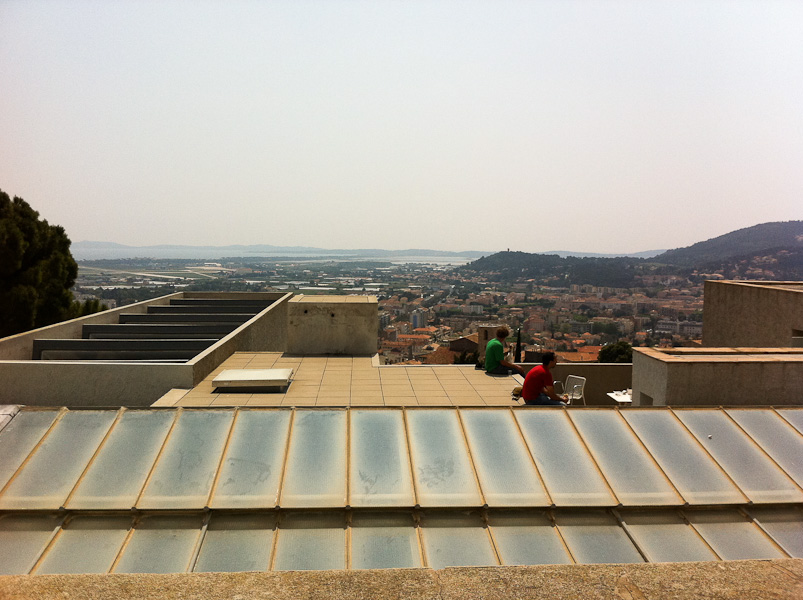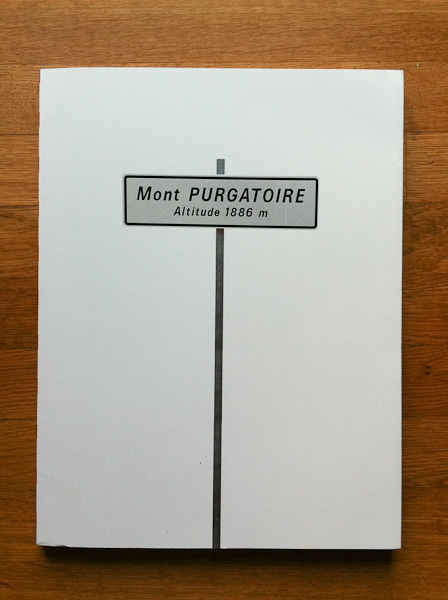The creative website of the franco-German TV channel Arte has started a great little weekly series of interviews with 'emerging' photographers entitled Picture this! The interviewees are not the usual suspects (I will confess I only recognised 2 or 3 names on the list), but it's the format of the interviews that is the real hook: the interview follows a standard 10-question format which is to be answered... in pictures. This often leads to visual gags, but it's interesting to see how the character of a photographer can emerge from such a small selection of pictures.
Marie Quéau from the series Gojira
Fototazo guest post
I have just done a short guest post over on the fototazo blog. fototazo has asked a group of 50 curators, gallery owners, blog writers, photographers, academics and others actively engaged in photography to pick two photographers that deserve (more) recognition - the underknown, the under-respected as well as not-appreciated-enough favorites. For my guest post, I selected Marie Quéau and Erik van der Weijde. Check out the post here.
Hyères 2011
 I've just recently returned from the 2011 edition of the Hyères fashion and photography festival which takes place at the Villa Noailles. For those who are not familiar with Hyères (I was not until a couple of years ago) it's important to note the use of the word "and" between 'fashion' and 'photography'. This is not a fashion photography festival but a festival with two distinct parts. Given that I know next-to-nothing about fashion photography and possibly even less about fashion itself, I wasn't sure what to expect, but I came back genuinely energised.
I've just recently returned from the 2011 edition of the Hyères fashion and photography festival which takes place at the Villa Noailles. For those who are not familiar with Hyères (I was not until a couple of years ago) it's important to note the use of the word "and" between 'fashion' and 'photography'. This is not a fashion photography festival but a festival with two distinct parts. Given that I know next-to-nothing about fashion photography and possibly even less about fashion itself, I wasn't sure what to expect, but I came back genuinely energised.
Hyères doesn't have the same visibility as the Rencontres d'Arles and in fairness the festival takes place on a much more intimate scale than the vast sprawl of it's cousin from up the road. Whereas a lot of the work being presented in Arles is well-known and critically recognised, Hyères functions more like a photographic incubator, both by focusing the competition on emerging young talent and also by exhibiting work that you are unlikely to see elsewhere. For instance the 2011 festival included a selection of Erwin Blumenfeld's photographs all of which were used as Vogue covers, something you are unlikely to see in a photography museum. After seeing this show and stepping into a newsagents, I couldn't help feeling that fashion photography as a genre seems to have regressed hugely from the inventiveness and experimentation of Blumenfeld's era, particularly for established magazines like Vogue.
The core of the photography component of the festival is a group exhibition of a shortlist of 10 emerging photographers, one or several of whom are selected by a jury for a grand prize. A look back at the shortlisted photographers from previous festivals and you are guaranteed to find not only excellent and exciting work and a lot of genuine discoveries. This year was no different, with work by Andrey Bogush, Kim Boske, Emily Hyperion Dubuisson, Katarina Elvén, Anouk Kruithof, Ina Jang, Mårten Lange, Marie Queau, Awoiska van der Molen and Marc Philip van Kempen. Most of the short-listed photographers have no experience of fashion photography at all and, in addition to the grand prize, a few of them may find themselves trying their hand at it for the first time following Hyères, an exercise which I think would be fascinating for any emerging photographer.
This year's grand prize winner was the young Dutch photographer Anouk Kruithof. She was selected unanimously by the jury for her inventiveness and her versatility. The series she presented at Hyères, the Daily Exhaustion, is a wonderfully simple idea in an equally wonderfully simple book/zine form, but I also recommend a trip to her website which is full of interesting material. A special mention was also given to Katarina Elvén, a set designer from Sweden who is working on a an ambitious but very thoughtful project relating to surface and aesthetics... one to look out for in the future. I also made another discovery in Hyères, but this one was on the jury rather than the shortlist. Fellow jury member and a photographer, provocateur and penseur, Jason Evans: the man behind the Daily Nice, the New Scent, contributor to the terrific Words Without Pictures and much more.
One particularly refreshing aspect of the festival is the time that is allocated to see each photographer. Portfolio reviews, which appear to be becoming more and more popular, seldom offer more than 20 minutes per review whereas at Hyères jurors spend between anything between 30 minutes and 1h30 with each of the shortlisted photographers, almost enough time for a conversation. But the thing that really makes Hyères stand out from other photography festivals is that it creates a space to consider photography in a different context. Just by combining fashion and photography, the festival is forcing us to reconsider what we think of as photography and offering a reminder of how insular the 'fine art photography' world can be. Whether you like fashion photography (or any other applied photography for that matter) or not, it has to be recognised that it is too often dismissed as inferior or just plain ignored by the art photography world. During my four days in Hyères I found myself having more conversations about photography in its many different forms than I have at all the other photography festivals I have attended put together.
 Aside from these issues of substance, combine the fact that this all takes place in an absolutely gorgeous 1930s modernist villa and that being on photo-jury duty also involves a collective swim in the Mediterranean and you will understand why Hyères has immediately become a personal favourite.
Aside from these issues of substance, combine the fact that this all takes place in an absolutely gorgeous 1930s modernist villa and that being on photo-jury duty also involves a collective swim in the Mediterranean and you will understand why Hyères has immediately become a personal favourite.
Christophe Maout's city of light
Paris earned the nickname of 'ville lumière' (City of Light) from having been an ideological home to the age of enlightenment and for it's famous street lights. Like these lights, the 19th century Haussmanian architecture of the city has come to typify the French capital in most outsiders' imagining of the city. So Christophe Maout's vision of Paris in HomeLux might come as a bit of a shock. HomeLux is shot on the city's periphery, specifically off the boulevard périphérique, the main ring road surrounding the city. The périphérique ferries traffic around the city and is one of the few areas of Paris where towerblocks appear regularly. Many of these blocks bear the name of major brands in the form of brightly-coloured neon crowns, an advertising practice that is forbidden within the center of the city. The series struck me as a kind of allegory, a preserved city, suspended in time, surrounded by an army of advancing towerblocks shouting their commercial messages at the constant flow of cars circumnavigating the city. The rooftop perspectives in these night exposures give the buildings a different quality, their neon halos seeming to give each building its distinct personality. I met Maout at a dinner last December and, as he gave us a lift home, we drove past many of these buildings lighting up that freezing winter night. A very different view of the city of light.
Review: Adriaan van der Ploeg, Mont Purgatoire
After Mariken Wessels' two mysterious tomes (one of which was reviewed here) which seemed to make most 'best of 2010' photobook lists, our Dutch friends have done it again and produced a book which really should not exist. I couldn't help but try to imagine this book idea being pitched to any halfway-sane book publisher, "I want to do a big, 150-page book of portraits of out-of-shape, middle-aged men who try to cycle up this mountain that most people have never heard of, but which has a cool name. The portraits will all be taken from the same head-on perspective with some kind of telephoto lens, they'll be tightly cropped and really flat and even out of focus sometimes because they're cycling up a mountain and the guys will all be sweating and in varying degrees of pain. Oh and as a bonus feature, I'll throw in a promotional website with a background video of one of the cyclists throwing up on the side of the road while some other guys ride past him." 99% of the time he would literally be escorted out of the building, possibly with a restraining order thrown in for good measure, and yet the good people of Habbekrats decided that there was some part of this project that was actually a good idea. The funny thing is that they were right.
There is nothing about this book that should interest me. I'm all for the odd bike ride but serious cycling leaves me cold... sweaty middle-aged men trying to reach their physical limits leaves me even colder. And yet, I was drawn in. Like it's non-illustrated cousins, 2008's Netherland about New York cricketers and current favourite The Hare with Amber Eyes (a 350-page book written about a collection of Japanese netsuke, tiny bone or ivory sculptures), Mont Purgatoire is not really about its (not particularly sexy) subject. Although the book comes with a number of essays written by cyclists, cycling poets and sports writers, the photographs it contains provide no context of the gruelling cycle that these men undertake to make it to the top of this mountain. For all we know, Van der Ploeg never even went near the place. I don't think it's going to reach quite the same sales figures as its fictional cousins, but what I found interesting is the way that it goes beyond its apparent subject to become a kind of study of the way we express feeling. Thumbing through its pages, you can't help but wonder what is going through these men's minds and why they are attempting this punishing climb. Their expressions convey the emotions that you would expect determination, exhaustion, focus, but often also a strong sense of introspection, as if this was less about proving their physical resilience or strength and more a process of self-flagellation.
As with most of the Dutch photo-books I've set my hands on of late, the book is very well made, with a really simple but intelligent and appropriate design. I particularly enjoyed the way that the essays were printed on newsprintish paper and designed to look like excerpts of a fictional (?) local Dutch newspaper. In its own (tongue-in-cheek, faux-Hollywood) words "Mont Purgatoire is an extraordinary photography-project about ordinary men, voluntarily battling their own strength on the steepest slopes." If you're curious to find out more, check out the book's website and I also recommend a trip to Van der Ploeg's website to get a view of his interest in the human face and what he has been doing with it in other contexts.
Adriaan van der Ploeg, Mont Purgatoire. Habbekrats (Soft cover, 144 pages, colour plates, 2010).
Rating: Recommended








